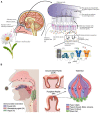Evaluating palatability in young children: a mini-review of relevant physiology and assessment techniques
- PMID: 38390280
- PMCID: PMC10881860
- DOI: 10.3389/fped.2024.1350662
Evaluating palatability in young children: a mini-review of relevant physiology and assessment techniques
Abstract
The palatability of pediatric pharmaceutical products plays a crucial role of influencing medication compliance. Rejection of unpalatable medications can potentially lead to treatment failure which can have immediate and delayed consequences. With advances in both the food and pharmaceutical industries, the systematic assessment of palatability has gained importance. Various methods such as visual analogue scales, facial hedonic scales, and facial recognition software, have been employed to assess palatability. While proven to be useful, these methods have significant limitations and may not be workable for young children. Despite these advancements, a universally accepted "gold standard" for assessing pediatric mediation palatability, recognized by drug regulatory agencies, is yet to be established.
Keywords: children; medicine; palatability; taste physiology; viscosity.
© 2024 Schluterman, Linardos, Drulia, Marshall and Kearns.
Conflict of interest statement
The authors declare that the research was conducted in the absence of any commercial or financial relationships that could be construed as a potential conflict of interest.
Figures


Similar articles
-
A Pilot Comparison of High- Versus Low-Tech Palatability Assessment Tools in Young Children.Paediatr Drugs. 2021 Jan;23(1):95-104. doi: 10.1007/s40272-020-00430-2. Epub 2020 Nov 25. Paediatr Drugs. 2021. PMID: 33236188
-
A Systematic Literature Review on the Assessment of Palatability and Swallowability in the Development of Oral Dosage Forms for Pediatric Patients.Ther Innov Regul Sci. 2013 Sep;47(5):533-541. doi: 10.1177/2168479013500288. Ther Innov Regul Sci. 2013. PMID: 30235574
-
Industry Survey on Current Practices in the Assessment of Palatability and Swallowability in the Development of Pediatric Oral Dosage Forms.Ther Innov Regul Sci. 2013 Sep;47(5):542-549. doi: 10.1177/2168479013500287. Ther Innov Regul Sci. 2013. PMID: 30235578
-
Prescribing for children - taste and palatability affect adherence to antibiotics: a review.Arch Dis Child. 2012 Mar;97(3):293-7. doi: 10.1136/archdischild-2011-300909. Epub 2011 Nov 16. Arch Dis Child. 2012. PMID: 22088684 Review.
-
Patent landscape of pediatric-friendly oral dosage forms and administration devices.Expert Opin Ther Pat. 2021 Jul;31(7):663-686. doi: 10.1080/13543776.2021.1893691. Epub 2021 Apr 19. Expert Opin Ther Pat. 2021. PMID: 33605825 Review.
Cited by
-
First-in-human safety, tolerability, pharmacokinetics and pilot food-effect study of the candidate antimalarial compound MMV367.Br J Clin Pharmacol. 2025 Jun;91(6):1821-1833. doi: 10.1111/bcp.70000. Br J Clin Pharmacol. 2025. PMID: 40441679 Free PMC article. Clinical Trial.
-
First-in-human safety, tolerability, pharmacokinetics and pilot food-effect study of the candidate antimalarial compound MMV367.Br J Clin Pharmacol. 2025 Jun;91(6):1821-1833. doi: 10.1002/bcp.70000. Epub 2025 Feb 16. Br J Clin Pharmacol. 2025. PMID: 39957009 Free PMC article. Clinical Trial.
References
-
- Shimokawa K, Itabashi T, Yamazaki N, Hino F, Ishii F. Survey of administration methods with view to improving compliance in pediatric patients. J Pharm Health Care Sci. (2009) 35:662–8. 10.5649/jjphcs.35.662 - DOI
Publication types
LinkOut - more resources
Full Text Sources

